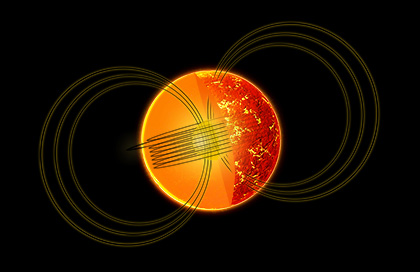What Lies Beneath? Magnetar Enigma Deepens
Illustration: NASA/CXC/M.Weiss
Observations with NASA's Chandra, Swift, and Rossi X-ray observatories, Fermi Gamma-ray Space Telescope, and ESA's XMM-Newton have revealed that a slowly rotating neutron star with a comparatively very weak surface magnetic field is giving off bursts of X-rays and gamma rays. This discovery may indicate the presence of an internal magnetic field much more intense than the surface magnetic field, with implications for how the most powerful magnets in the cosmos evolve.
The neutron star, SGR 0418+5729, was discovered on June 5, 2009 when the Fermi Gamma-ray Space Telescope detected bursts of gamma-rays from this object. Follow-up observations four days later with the Rossi X-Ray Timing Explorer (RXTE) showed that, in addition to sporadic X-ray bursts, the neutron star exhibits persistent X-ray emission with regular pulsations that indicate that the star has a rotational period of 9.1 seconds. RXTE was able to monitor this activity for about 100 days. This behavior is similar to a class of neutron stars call magnetars, which have strong to extreme magnetic fields 20 to 100 times above the average of the galactic radio pulsars.
As neutron stars rotate, the radiation of low frequency electromagnetic waves or winds of high-energy particles carry energy away from the star, causing the rotation rate of the star to gradually decrease. Careful monitoring of SGR 0418 was possible because Chandra and XMM-Newton were able to measure its pulsation period even though it faded by a factor of 10 after the initial detection. What sets SGR 0418 apart from other magnetars is that careful monitoring over a span of 490 days has revealed no detectable decrease in its rotation rate.
-Megan Watzke, CXC
Please note this is a moderated blog. No pornography, spam, profanity or discriminatory remarks are allowed. No personal attacks are allowed. Users should stay on topic to keep it relevant for the readers.
Read the privacy statement

